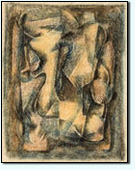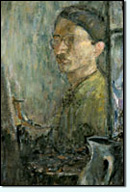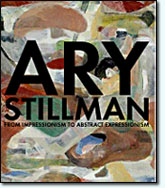Publications
Reminiscences > Summer Cottage in Harmon (1942)
The Foundation collection contains several canvases painted in the summer of 1942. The two largest and most impressive are a forest of tangled green trees, named simply "Trees" (Now belongs to Fredell and Ralph.) and a colorful still life with a table bearing flowers and fruit and teapot, standing in front of a window which looks out on the same forest. Ary called it "Summer Day" (Now belongs to Barry Lack) and it was shown and praised in several group exhibitions.
The locale for these paintings was our summer cottage in Harmon, on the Hudson River, the first summer after our marriage. Ary thought we should find a place for the summer, but we had so little money, it was a problem. Several artists had summer places in Croton, which adjoined Harmon, and in the surrounding hills, which made Ary think of this vicinity. The real estate agent whom we contacted at Harmon proved to be the son of a painter who had studied at the Chicago Art Institute when Ary was there briefly, years before, and he knew exactly what we wanted. "I know a place," he said, "which is so crazy that only an artist could possibly want it, but I think it may be just what you are looking for." And it was. Not for me, I must admit — the ceilings were so low I felt hemmed in, and the whole place was so unkempt. Then there was the matter of furniture, but Ary said that an auction house he knew down on University Place could take care of that. So of course I gave in, and I grew to love the place almost as much as Ary did.
“As the agent remarked, Margaret Mayo seemed to have built a fireplace and a house around it. The fireplace was the chief feature of an enormous living room.”
It was one of several houses built by Margaret Mayo, a playwright of that period. As the agent remarked, she seemed to have built a fireplace and a house around it. The fireplace was the chief feature of an enormous living room. The remainder of the ground floor consisted of a large kitchen and a bathroom. The narrowest of stairs led to the bedroom on the second floor. Outside the bedroom was a large verandah, which was practically in the treetops, for a large maple tree overhung the greater part of the porch and shielded it from public view.
Ary bought $25 worth of furniture at the University Place auction house, and paid another $25 to have it brought out from New York. The beds and other bedroom furniture had to be hauled up with ropes from outside, since the narrow stairway wouldn't permit carrying the larger pieces by hand.
An unbelievable quantity of furniture made up that $25 purchase — besides the bedroom pieces a huge table for the living room, a sofa, chairs, etc. The landlord provided a small ice-box and the iceman was to come every other day. But when Ary's friend Paul Burt came to visit us several weeks later he insisted that we must have a Frigidaire — he had some connection with a company that handled them. So after another couple of weeks a most impressive looking Frigidaire arrived. Unfortunately, after a little while the Frigidaire broke down, and we found that it wasn't worth repairing. By that time the landlord had taken the ice-box away and we couldn't get it back. So the rest of the summer we had to buy our provisions day by day.
The ceilings were indeed low. Our niece Fredell Lack, the violinist, came to visit us one weekend, bringing her violin with her, and she found that there were only two or three spots where she could practice, so that her bow wouldn't strike the ceiling. And the ceiling had other drawbacks; we found that out with the first rain. We soon learned to cope with that; at the first downpour out would come the pans and kettles from the kitchen, and we knew just where to place them on the floor so as to catch the rain.
But whatever discrepancies the house had were compensated for by its surroundings. At the side of the house there was a big cherry tree, which was lovely when in bloom, and heavy with fruit later on. Ary had a race with the robins to pick the fruit when it was ripe. I can see him now, up on a ladder, gathering in the red cherries, with all the excitement and delight of a small boy. I made preserves from the fruit; I let it cook too long and it came out with a curious, almost burnt flavor, which was amazingly good.

Flowers and Koschka
1942, oil on canvas, 24 x 18 in.,
[Foundation Collection, TX]
In the back of the house was a wide stretch of forest. Evidently it once had been cultivated, for there were remains of rose beds and bushes and flowers which someone must have planted. Now, however, it was untended. It proved to be a treasure-trove, for each day some new flower would appear in what had seemed the previous day to be only a tangle of underbrush. There were bushes of berries also — I don't know if they were wild or cultivated, but the fruit was delicious. Ary, who would meet me at the railroad station each evening when I came home from my work in New York, would take me first to the forest to see his newest discovery. There were squirrels in the woods, and rabbits, and all sorts of birds. Outside the windows of the house spiders would spin their webs, and Ary would watch with rapt attention, as the spiders would perform a courtship dance. Unfortunately for my peace of mind we would hear mice scampering around on the floor below as we were in our upstairs bedroom at night, and squirrels would run across the roof. Ary taught me to be a little more friendly towards these animals. But I really couldn't feel happy about the mice, even the white mice which evidently had been tame at one time.
Koschka didn't like the white mice either. Koschka was the black cat who followed us home one night as we were taking a walk, and then proceeded to adopt us. She (or I supposed it was really he) had the soul of a tiger, but she took a mad fancy to Ary and loved to spend her time with him. Evenings as we talked or read she would spread herself out across his chest, her paws embracing him and her eyes intent on his. And all night long she would sit outside our bedroom door, ready to rush in when I opened the door in the morning and jump up on Ary's bed. I told Ary I thought she was the reincarnation of Cleopatra, or some such passionate beauty. Beautiful she was, and wild; she would disappear for days, roaming no one knows where, and then suddenly as we would walk across the lawn, she would plummet herself down from one of the trees, landing right on Ary's shoulder.
As for the white mice — one afternoon when I came home Ary met me quite excited and triumphant. Koschka had caught one of the white mice, he said, and he found her in the yard, playing with it, the mouse desperately trying to escape, and Koschka pulling her back each time. What to do? Koschka wouldn't listen to him. So he got a big kettle from the kitchen and once when the mouse had pulled away from Koschka he threw the kettle over it. Koschka, deprived of her plaything, soon became bored and went away to find other excitement, and then Ary lifted the kettle and let the bedraggled white mouse escape.
Among the canvases we never parted with is a painting depicting a corner of the living room, a big bowl of wild flowers on the table, and Koschka by the door, in that tense attitude of expectation that she took on when she looked out at the forest, which had such a rich store of small field animals and insects to investigate.
When we left Harmon at the end of the summer Ary found a fellow-artist who was glad to take Koschka to his home in the nearby countryside. When he came to the cottage to get her, Koschka fought and clawed at him with all the tiger blood in her nature. He finally succeeded in carrying her off and she had a happy home with him and his family for a short time. We heard from him later however that she had accidentally been killed; they did everything possible to save her, but in vain. Perhaps Koschka was destined for that summer with Ary and that alone.
It was nearing the end of the season and time to go back to New York. Ary had a second-hand dealer come in to give us a price on the furniture. He said the most he would pay was $10, including the incapacitated Frigidaire. Ary said no, he would rather leave the furniture for the next person who would rent the place. He went back there once and found the house unoccupied. I don't know what became of it after that.
Copyright © 2002-2007 The Stillman-Lack Foundation.
All text and images on this site may not be published, broadcast, or distributed in any form without the prior written permission of The Stillman-Lack Foundation.





